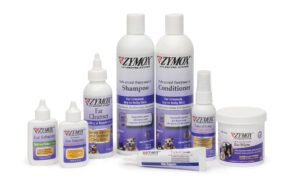Digging Deep Into Skin and Ear Challenges in Cats and Kittens

By Carol Bryant, Professional Pet Blogger
Cats are the second most popular pet in the United States. According to the American Pet Products Association (APPA), 45.5 million U.S. households own a pet. As with any pet, there are health issues to be aware of, and cats are no different. Skin and ear issues in cats rank in the top 10 reasons they see a veterinarian. In 2022, Americans spent a whopping $35.9 billion on veterinary care and associated products. In this article, we’ll explore the common ear and skin problems affecting cats, how to arm yourself with a preventative plan, and signs and symptoms that indicate trouble.
Feline Ear Anatomy
Cat’s ears are fascinating and intricate and finely tuned to detect even the faintest of sounds. If you’ve ever watched your cat slinking around the house as if she were a lioness in the jungle, her hearing is on high alert. Thanks to the network of hair cells deep within the cochlea of their ears, cats are known for their acute hearing ability. Like humans, cats’ ears are designed for hearing and balance. Take a good look at your cat’s outer ear. See that little pouch on the outside? That’s a prime location for parasites to gather since it is dark and recessed, which critters love. Because a cat’s ear canal is much deeper than a human’s, it is prone to wax and dirt buildup, leading to inflammation and secondary infections. Fortunately, there’s a proven way to combat this buildup to keep your cat’s ears healthy and clean. More about that shortly.
Feline Skin Facts
The skin is the largest organ of a cat’s body. It protects her against dryness and pathogens and is about 12 to 24 percent of her total body weight. The condition of a cat’s skin is a good indicator of her overall health. If your cat experiences chronic or long-standing illness or stress, it will likely show in her skin. Everything from metabolic issues like an overactive thyroid (hyperthyroidism) to parasites to chronic diarrhea and even cancer can affect a cat’s coat and skin. Cats have an oily substance in their skin called sebum. Sebum helps moisturize the fur and skin but too much of it can lead to oily skin or feline acne. Feline skin is generally thin compared to other animals, so environmental and dietary irritants can cause strong reactions.
Common Ear and Skin Problems In Cats
Some of the more common ear problems of cats and kittens include:
- Ear mites: Tiny parasites that can cause head shaking, discomfort, and head shaking.
- Ear infections: Caused by bacteria or yeast, causing redness, swelling, and odor.
- Otitis externa: Inflammation of the external ear canal caused by allergies, foreign body, or moisture buildup.
- Hematoma: Blood-filled swelling in the ear due to head shaking or excessive scratching.
- Polyps: Growths that develop within a cat’s ears, associated with head tilting, balance problems, and irritation.
Skin problems commonly seen in cats and kittens are:
- Fleas and flea allergic dermatitis: Reactions to fleas include discomfort, itching, hair loss, and skin irritation.
- Allergies: Both environmental and food, this can be ongoing or temporary and involve itching, secondary infections, and overall redness and discomfort.
- Ringworm: A fungal infection of the skin causing circular areas of hair loss, scales, and redness. Ringworm is contagious to other pets and people.
- Hot spots: Caused by itching, licking, or biting the skin, hot spots are also known as acute moist dermatitis and can lead to secondary infection if not treated properly.
- Mange: Caused by burrowing mites in the skin that cause itching, inflammation, and hair loss.
- Bacterial infections: Often caused by a weak immune system or as a secondary reaction from other skin issues leading to pustules, redness, and hair loss.
Solutions For Ear and Skin Problems in Cats
If you suspect your cat has an infection, is in pain, or is experiencing ear or skin discomfort, always seek veterinary care. Famed veterinarian Dr. Lindsay Butzer recommends pet parents clean
their cats’ ears with ZYMOX® products. In a YouTube video featuring Instagram-famous Maine Coon cat, Dante, Dr. Butzer shows how to treat a cat’s ear infection using ZYMOX Ear Cleanser and ZYMOX hydrocortisone-free Ear Solution.
WATCH VIDEO HERE https://www.youtube.com/watch?v=U46oGvRpP6E
 ZYMOX offers both ear and skin enzymatic products for cats and kittens for over 25 years. Their LP3 Enzyme System uses zero antibiotics and contains no harsh ingredients. The International Cat Association (TICA), the feline version of the American Kennel Club for dogs, endorses ZYMOX products because they are non-toxic and easy to use with no harmful ingredients.
ZYMOX offers both ear and skin enzymatic products for cats and kittens for over 25 years. Their LP3 Enzyme System uses zero antibiotics and contains no harsh ingredients. The International Cat Association (TICA), the feline version of the American Kennel Club for dogs, endorses ZYMOX products because they are non-toxic and easy to use with no harmful ingredients.
Where Cat Parents Can Find ZYMOX Products
Learn all about ZYMOX Dermatology and Oratene Brushless Oral Care by visiting the Zymox website to view the product line: https://zymox.com/products/ Brick-and-mortar national brands and independent pet specialty stores across the country offer Pet King Brands’ ZYMOX® and Oratene® products. To find nearby pet specialty stores that sell ZYMOX products, visit their Where To Buy page, https://zymox.com/where-to-buy/.
About the Author

Gayle King introduced Carol Bryant as a “dog lover of the highest order” when she and her Cocker Spaniel, Dexter, appeared on Oprah Radio. Carol is well-known in the pet industry, having appeared on television, radio shows, and podcasts, as well as in articles from CNN and Yahoo to Dogster and Today.com. She is the founder of the award-winning blog FidoseofReality.com and is the Immediate Past President of the Dog Writers Association of America.

